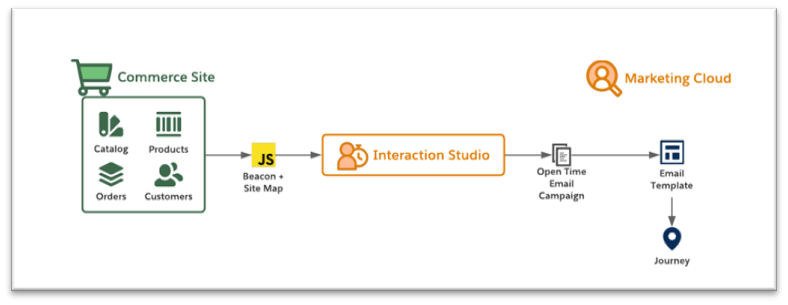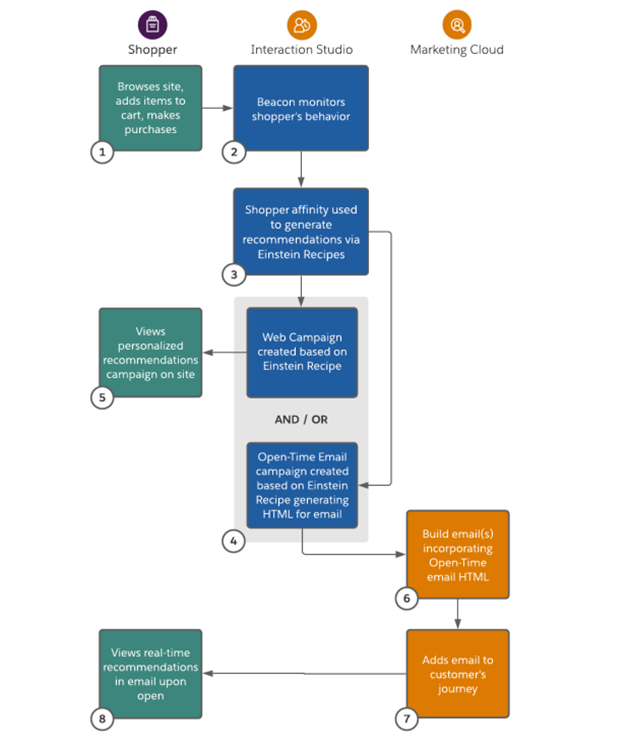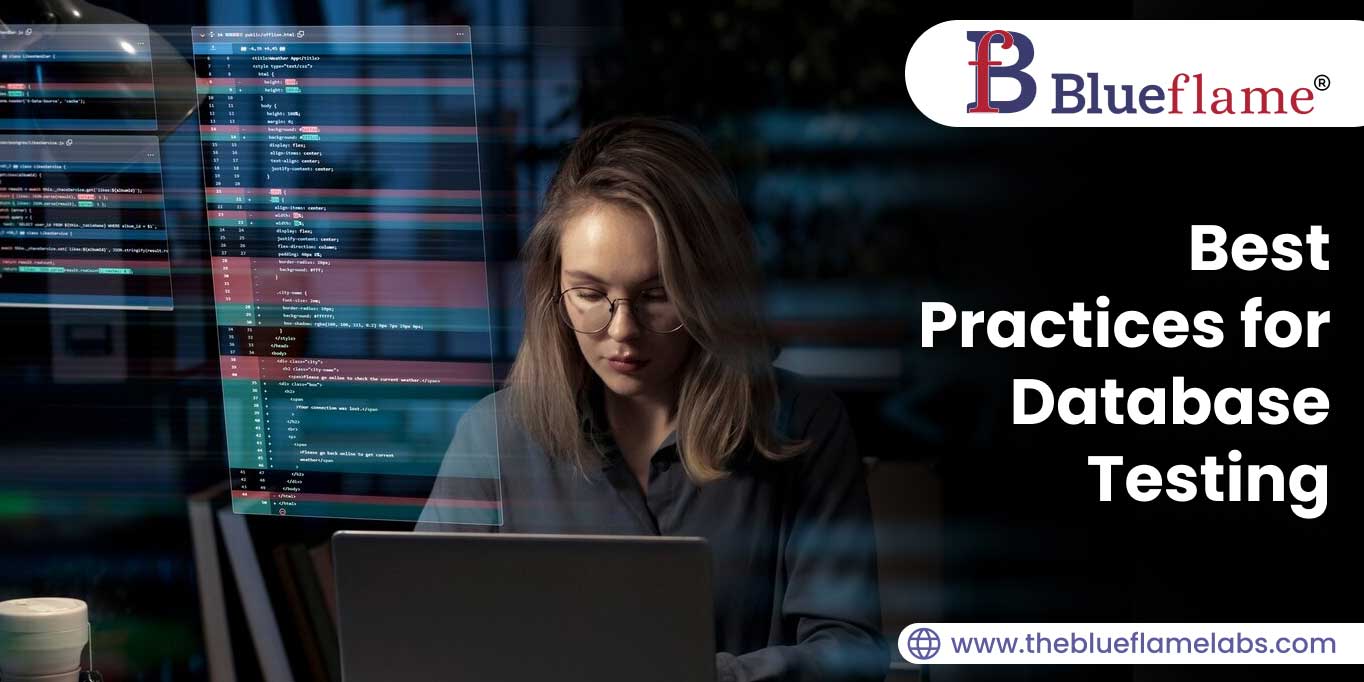Marketing Cloud Personalization
Marketing Cloud Personalization (formerly known as Interaction Studio), enables businesses to create, deliver, and manage highly personalized and relevant customer experiences across various digital marketing channels.
Why Marketing Cloud Personalization?
In a digital world thousands and millions of people interact with each other, every person is unique, and they want to be treated uniquely with a personal touch.
Customers or prospects expect companies to understand them, know what they want, and give them useful and fitting experiences. In fact, the experience a company offers to its customers has become a significant factor that sets brands apart from each other. So, it has become crucial to the company’s marketers to deliver a unique experience every time to each customer in a helpful and trusted way.
Using Marketing Cloud Personalization, the channels in which customer interactions take place can be personalized. Below are a few common channels from which the customer information or behavior is tracked in a real time, this information is further used to engage with the customer.
- Websites
- Mobile apps
- Emails
- Web apps (like a SaaS application)
- In-store/in-branch communications
A wide range of customer or prospect information from the above channels can be used to tailor marketing campaigns. The goal is to create a more personalized and relevant experience for every customer or prospect.
Taking Action Based On
Below information can be captured using Marketing Cloud Personalization on which Marketers can take action to create a unique experience with every customer.
Contact Information (Email address, Phone number, Mailing address, Billing address, etc.)
Demographic Information (Name, Age, Gender, Location, Language Preference, etc.), Behavioral Data (Website interactions (pages visited, products viewed, time spent), Purchase history, Abandoned carts, etc)
Device and Platform Data: Device type (mobile, desktop, tablet), Operating System, etc.
Geographical Data: Location-based information (e.g., nearest store location, customer’s location, etc)
User Profile Data: Profile settings and preferences of the customer/prospect
Predictive Analytics: Predictive models that estimate customer behavior and preferences based on historical data
Through strategic utilization of this data, marketers can design personalized marketing campaigns, customize content according to individual prospect or the customer then send message at precise moment through the most suitable channels like email, personalized views on websites, Mobile apps, etc.
By using this information, the Marketer can decide on how and when to best interact with them on the channels they use.
Integrating Marketing Cloud Personalization with Website to track the user activities on Website

JavaScript beacon code
A JavaScript beacon code is available in Marketing Cloud Personalization, it is essential for data exchange between the Personalization platform and the SDK libraries employed on the website. It monitors and tracks the online behavior of your web users. When any registered user or anonymous user interacts with your website, the JavaScript beacon sets a first-party cookie in the visitor's browser, transmitting data about the visitor to the Personalization platform.
Personalization Sitemap
A Sitemap is used as a JavaScript configuration that shows the implementation of the web channel solution plan for tracking events. It enables to collect the user interactivity data from the website.
The JavaScript setup in a Personalization Sitemap facilitates the functionality required for Personalization to recognize the following.
- User Profiles: Identity, achieved through either a recognized user ID or an anonymous user tracking ID.
- Page Types: The category of page the user is currently exploring. (Home page, Product page, Product Detail page, etc.).
- Attributes: Comprehensive information regarding the user's attributes and their engagement with business objects.
- Events: Varieties of user actions to monitor that initiate events for Personalization.
Campaigns
Based on the type of license you have for Marketing Cloud Personalization, you can create campaigns for various channels like web, email, mobile, and third-party integrations.
At the core, campaigns drive the delivery of personalized experiences across each of these channels.
As mentioned in below diagram
1) the customer’s activities(like visit, cart items, etc) on the website are captured.
2) The JavaScript beacon code will capture all the events or activities performed by the customer.
3) Based on customer’s preferences the recommendations are given by marketing cloud personalization.
4) Campaigns sets recommendations to demonstrate engagement.
5) The customer views their personalized recommendations on-site.
6) Marketing Cloud constructs an email by utilizing the HTML derived from the Open-Time email campaigns within Marketing Cloud Personalization.
7) Marketing Cloud incorporates an email into the customer's journey.
8) The shopper observes the email containing real-time personalized recommendations upon opening it.

1. Web Campaign
Through a web-based campaign, you can customize different elements of your website to cater to your users, taking into account their actions, interests, preferences, choices, location, and other relevant factors.
Use Web Templates with Web Campaigns
You can generate online campaigns using a web campaign template designed by a developer.
Getting started with Marketing Cloud Personalization templates is effortless due to the availability of preconfigured templates.
With a thoughtfully designed template, any team member can initiate, evaluate, and launch a web campaign.
Common Pre-built Template:
- Popup messages: Popup campaigns offer versatile applications, spanning from addressing cart abandonment to capturing emails. These popup messages usually encompass text, an image, and a call-to-action, which could be in the form of a button or an input field.
- Infobar messages: These messages are designed so that they capture the user’s attention. Infobar messages are either the page's upper or lower edge. Similar to popup messages, they function as attention captivators.
- Inline messages: Inline messages find frequent applications in campaigns related to product or content recommendations. For example, you can personalize the main section of the homepage for users across diverse geographical regions or industries, taking into account their affinities and preferences.
2. Open Time Email Campaign
Utilize open-time email campaigns to provide individualized content and product suggestions whenever an email recipient opens the message.
On the higher level, any activity by the website customer will be tracked by Marketing Cloud Personalization. These captured events will be further used for personalized email communications with the customers.
Prior to creating an Open Time Email campaign, you need to develop an open time item template that governs the presentation of content and product recommendations within your email campaigns.
Insert HTML code into email templates as provided by the email campaign wherever required Once your email template is finalized, conduct testing within your email marketing platform.
Due to the Marketing Cloud Personalization features like dynamic content, open-time personalization, and real-time tracking, it enables businesses to deliver relevant messages to the right audience at the right time. This leads to improved customer experiences and more effective marketing strategies.
To know more about Marketing Cloud Personalization, get in touch with us today. Blueflame Labs is a leading implementation partner of Salesforce, providing customers with the best Salesforce solutions.











 Strictly Necessary Cookies
Strictly Necessary Cookies